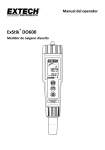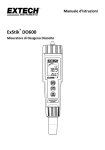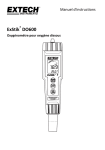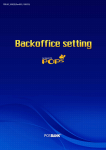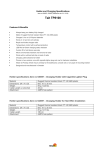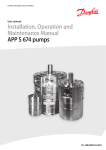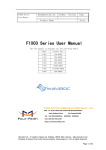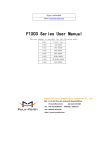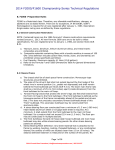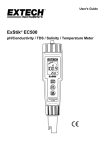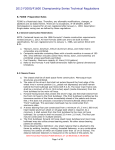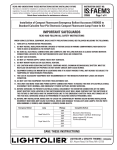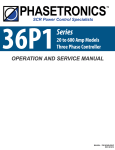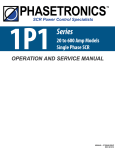Download ExStik DO600 - Extech Instruments
Transcript
USER GUIDE ExStik® DO600 Dissolved Oxygen Meter II RECALL Dissolved Oxygen DO600 Introduction Congratulations on your purchase of the ExStik® DO600 dissolved oxygen / temperature meter which simultaneously displays dissolved oxygen and temperature. Units of measure are % saturation, mg/l or ppm for dissolved oxygen, and °C or °F for temperature. Advanced features include Data Hold, 25 points memory, auto power off, automatic temperature compensation, salinity and altitude compensation. This meter is shipped fully tested and calibrated and, with proper use, will provide years of reliable service. Please visit our website (www.extech.com) to check for the latest version of this User Guide, Product Updates, and Customer Support. Meter Description Front Panel Description 1 1. Battery compartment cover 2. LCD Display 2 3. MODE/HOLD button II 4. CAL/RECALL button 3 4 5 5. ON/OFF button 6. Electrode Retaining Collar 7. Dissolved Oxygen Sensor Dissolved Oxygen DO600 8. Bonded Membrane Cap assembly 6 9. Membrane & Cathode (Note: The Electrode storage cap is not shown) Electrode Bottom View RECALL 7 8 9 Membrane Cathode LCD Display 1. Bar graph display 2. Measurement units 3. Main display 4. Low Battery indicator 5. Temperature display 6. Reading hold indicator 2 DO600-en-GB_V7.3 7/15 Operation Prepare the Electrode The electrode is shipped “dry” and requires filling with the supplied electrolyte solution before use. The membrane should be in place and does not need replacement. Follow the procedure at the end of this guide for filling the bonded cap. NOTE: Make sure that there are no air bubbles in the electrode before use. Powering the ExStik® The ExStik® uses four (4) CR2032 Lithium Ion Batteries. Press the ON/OFF button to turn the meter on or off. If the batteries are weak, the ‘BAT’ indicator appears on the LCD. The auto ® power off feature shuts the ExStik off automatically after approximately 10 minutes of inactivity. The auto power off feature may be temporarily disabled for convenience or for extended polarization time. Startup Polarization Period When the ExStik® is powered up for the first time, the electrode requires polarization. In order for this to occur a three minute (approx.) polarization period must elapse before measurements can be made. A special circuit is included in this meter which, upon turn‐on, maintains a very small biasing current to the electrode for a period of seven days. This keeps the electrode polarized and enables the user to make immediate measurements (within a 7 day period) without waiting for the electrode to re‐polarize. Each time the ExStik® is turned on, the polarization timer is reset and the 7 day polarization period is initiated. A small asterisk at the bottom right corner of the display is used to indicate that the polarization timer circuit is active even when the meter is off. If the ExStik is not used for more than seven day, a 3 minute waiting period is required before a measurement can be made. Turn‐On Diagnostics 1. 2. 3. 4. When the meter is turned ON the LCD displays “SELF” and “CAL” while the meter runs a diagnostic routine. During this time the meter is recalling the User Calibration data, performing self diagnostics & initializing the circuitry. After this function is complete, the meter proceeds to the normal measurement mode. The DO600 should be calibrated daily for measurement accuracy. 3 DO600-en-GB_V7.3 7/15 Calibration 1. 2. 3. 4. 5. 6. 7. 8. 9. Calibration should be performed on a daily basis. Turn the meter ON Press and hold the MODE/HOLD button until % is displayed on the LCD. If the meter has not been used for seven (7) days or longer, allow the electrode to fully polarize. This may take 2‐3 minutes. Place the electrode cap onto the electrode. The sponge contained in the cap should be only moistened (not soaked) with (distilled water) or clean tap water. Be sure that the electrode membrane is clean and dry or the calibration will be incorrect. There needs to be an air gap between the membrane and the sponge. Never touch the membrane, as skin oil will affect the electrode response. Wait until the reading stabilizes then press and hold the CAL/RECALL button until CAL is shown in the lower display. The readings will blink “101.7” and “SA” will appear. When the calibration is complete “End” will appear and then the meter will return to the normal measurement mode. Turn off the meter. Note: The “SA” will not appear if the calibration fails. Optional ’zero oxygen’ calibration (improves measurement accuracy for very low or very high DO measurements): Place the electrode in a zero oxygen calibration solution, such as 5% sodium sulfite, wait for stability and press the CAL/RECALL button until CAL is shown in the in the lower display. Stability in a zero solution may take many minutes, depending on electrode history. Note: Sodium Sulfite can become deposited on the electrode and on the “coined” surface of the electrode retaining collar. The presence of the Sodium Sulfite will negatively affect future DO measurements until such a time where ALL of it is removed from the electrode. Optional Electronic Zero calibration. If the DO600 is not making stable measurements or you are replacing the electrode with a new assembly, perform this Zero calibration. Turn off the meter, remove the electrode by unscrewing the retaining ring and pull off the electrode. Turn on the meter and wait for the Self calibration to complete. Set the Mode to %. Press and Hold the CAL button until CAL appears on the display. When the cal cycle completes, the display should read 0.0%. Turn off the meter. Re‐attach the electrode. Perform the electrode cap calibration from Step 5. 4 DO600-en-GB_V7.3 7/15 Measurements 1. 2. 3. 4. 5. Cover the electrode with the electrode cap. The sponge contained in the cap should be moistened (not soaked) with (distilled water) or clean tap water. Pressing the ON/OFF button turns the meter ON or OFF. When turned ON, the meter’s display switches on and the Self Calibration utility runs (see above). If this is the first time the meter is powered up, wait approx. 3 minutes for the probe to polarize (please disable auto‐power off; Instructions for disabling auto‐power off are provided in a later section). For more details, please read the Startup Polarization Period paragraph earlier in this manual before continuing. Select the desired units of measure by pressing and holding the MODE/HOLD button until the proper units are shown in the display. Remove the electrode cover and place the electrode in the sample to be measured. Stir the electrode in the sample to remove any trapped air bubbles from the membrane surface. Do not submerse the electrode to the point that the sample liquid reaches the meter’s electrode collar. Allow the meter time to settle to the final measurement value. Note: The larger the difference in temperature between the electrode and the solution the longer it will take for the reading to stabilize. Stabilization time can vary from thirty (30) seconds to five (5) minutes. Measurement Units The meter can be set to measure either % saturation, mg/l, or parts per million (ppm). To change the mode: 1. Press and hold the MODE/HOLD button for 2 seconds and the display will begin to scroll through the different units of measure : % saturation; D.O. in mg/l; D.O. in ppm (parts per million) 2. When the desired units are displayed, release the MODE/HOLD button and the unit will return to normal operating mode. Note: The “HOLD” function cannot be on when changing the measurement function. If “HOLD” is displayed in the lower left corner of the display, briefly press the MODE/HOLD button to turn it off. Temperature Units (ºF / ºC) 1. 2. 3. With the unit OFF, press and hold the CAL/RECALL button. With the CAL/RECALL button depressed, momentarily press the ON/OFF button to turn the unit ON. The CAL/RECALL button can be released when ‘Self Cal’ is shown in the display. Salinity Compensation 1. 2. With the unit ON, momentarily press the CAL/RECALL button twice in quick succession (‘SAL’ is shown in the lower temperature display). Momentary press the MODE/HOLD button. Each press of the MODE/HOLD button increases the compensation by 1ppt (part per thousand); the available range is 0 to 50ppt. 5 DO600-en-GB_V7.3 7/15 3. Momentarily press the CAL/RECALL button to save the compensation setting and return to the normal measurement mode. Altitude Compensation 1. 2. 3. 4. With the unit ON, momentarily press the CAL/RECALL button twice in quick succession (‘SAL’ is shown in the lower temperature display. Press and hold CAL/RECALL again for 2 seconds to enter the Altitude Mode (‘Ald’ will be shown in the lower temperature display). The factory default value is sea level. Each press of the MODE/HOLD button increases the compensation by 1000ft. The maximum value is 20 presses (20,000ft above sea level). Momentarily press the CAL/RECALL button to save the compensation setting and return to the normal measurement mode. Auto‐Power OFF Feature The auto power off feature automatically shuts the meter off 10 minutes after the most recent button press. To disable this feature, refer to the Disable Auto‐Power OFF section. Disable Auto‐Power OFF Feature With the unit ON, momentarily press the CAL/RECALL button, then quickly press and hold both the MODE/HOLD and ON/OFF buttons until ‘off’ is displayed. To restore the Auto Power Off Feature (auto power OFF enable) simply turn the meter off and on again using the ON/OFF button. Low Battery Indication When the battery voltage falls below the operating threshold, ‘BAT’ will appear on the display. Refer to the Maintenance section for battery replacement information. Storing Readings 1. 2. 3. Press the MODE/HOLD button to store a reading. The storage location number will be displayed on the lower display, while the main display shows the stored reading. The meter will enter the HOLD mode and the “HOLD” indicator will appear on the LCD. Press the MODE/HOLD button again to exit the HOLD mode and return to normal operation. The next time MODE/HOLD is momentarily pressed another reading is stored and so on. If more than 25 readings are stored, previously stored readings (starting with reading number 1) are overwritten. Recalling Stored Readings 1. 2. 3. Momentarily press the CAL/RECALL button and then with in 4 seconds momentarily press the MODE/HOLD. The last stored data point location will be displayed (1 to 25). Each time the MODE/HOLD button is momentarily pressed the next most recently stored data point will be displayed. After the last data point stored is displayed, pressing the MODE/HOLD button again returns the display to the beginning of the list. Pressing the CAL/RECALL button at anytime stops the data retrieval process and returns the meter to the normal measurement mode. 6 DO600-en-GB_V7.3 7/15 Clearing Stored Readings 1. 2. With the unit ON press and hold the ON/OFF button for 4 seconds When “clr” is shown in the main display the memory is cleared. Measurement and Display Considerations The DO600 uses a polarographic sensor, which consumes oxygen at the sensing surface. This requires a constant movement of the sample across the membrane to maintain a constant dissolved oxygen level. It is recommended that the probe be moved in the sample as the measurement is made, or if in a laboratory environment, the sample be stirred using a stir plate. If you are measuring DO in a small container, the probe will consume oxygen as it is measuring and the measurement value will continue to go lower. If the unit appears to be locked (display frozen). It is possible that the Data Hold mode has been inadvertently accessed by a press of the MODE/HOLD button (HOLD will be displayed in the bottom left of the LCD). Simply press the MODE/HOLD button again or turn the meter off and back on again. If the meter does latch up and no button presses revive it, remove the batteries and restart. For maximum accuracy, allow sufficient time for the temperature of the probe to reach the temperature of the sample before taking a reading. This will be indicated by a stable temperature reading on the display. Membrane Maintenance First use When you first go to use a new meter, you will need to remove the membrane cap and replace it with a new cap filled with refill solution. Please Note: The installation of a bonded cap causes the membrane to be tightly streched over the cathode. Once a bonded cap is removed reinstallation is not possible as the membrane will no longer be properly streched over the cathode. Storage The sponge contained in the protective electrode cap should be only moistened (not soaked) with (distilled water) or clean tap water. 7 DO600-en-GB_V7.3 7/15 Maintenance Battery Replacement 1. Twist off the battery compartment cover. 2. Holding the battery housing in place with a finger, pull out the battery carrier using the two small tabs. 3. Replace the four (4) CR2032 batteries observing proper polarity. 4. Replace the battery carrier, reattach the battery compartment cap and tighten securely. Never dispose of used batteries or rechargeable batteries in household waste. As consumers, users are legally required to take used batteries to appropriate collection sites, the retail store where the batteries were purchased, or wherever batteries are sold. Disposal: Do not dispose of this instrument in household waste. The user is obligated to take end‐of‐life devices to a designated collection point for the disposal of electrical and electronic equipment. Other Battery Safety Reminders o Never dispose of batteries in a fire. Batteries may explode or leak. o Never mix battery types. Always install new batteries of the same type. Electrode Replacement 1. 2. 3. 4. To remove the electrode, first turn the instrument OFF and then unscrew and remove the electrode retaining collar. (turn the collar counter‐clockwise to remove). Gently rock the electrode from side to side, pulling it away from the meter until it disconnects. To attach an electrode, align the positioning “keys” on the electrode and the main body housing and then carefully push the electrode into the meter socket until it is fully seated. Tighten the electrode retaining collar firmly enough to seal the electrode with the meter. 8 DO600-en-GB_V7.3 7/15 DO Bonded Membrane Cap replacement Important Note : Do not touch the membrane as skin oils will interfere with the oxygen permeability rate of the membrane. Use caution when replacing the bonded cap. 1. It is recommended that the electrode remain attached to the meter during this replacement process. 2. To remove the bonded cap from the electrode, unscrew the cap firmly and carefully counter‐clockwise from the electrode (see diagram below). 3. Discard the used cap. Please Note: The installation of a bonded cap causes the membrane to be tightly streched over the cathode. Once a bonded cap is removed reinstallation is not possible as the membrane will no longer be properly streched over the cathode. 4. Rinse the old electrolyte solution from the Cathode and Anode before continuing. 5. Use the supplied Polishing Paper (See Accessories table) to clean, polish, shine, and/or remove scratches from the cathode. Be sure to moisten the cloth before polishing the cathode. Do not over‐polish the sensitive gold cathode. 6. Set the new replacement bonded cap on a flat surface. Leave the cap in this position throughout the replacement process. 7. Fill the bonded cap with the electrolyte solution up to the bottom of the threads on the inside of the cap. 8. Tap the side of the bonded cap to help jar free any trapped air bubbles from the electrolyte solution. 9. Keeping the cap in a fixed position on a flat surface, carefully insert the electrode into the new bonded cap by first dipping and removing the electrode several times from the cap. With each dip, push the electrode progressively deeper into the bonded cap. Finally, screw the electrode slowly onto the bonded cap (clockwise) until fully tightened. The dipping and removal technique minimizes the introduction of air bubbles into the electrolyte solution. Air bubbles in the electrolyte can compromise measurements. 10. During the tightening of the bonded cap, excess electrolyte solution will leak out, this is normal and desireable since it minimizes the introduction of air pockets. Clean off the excess electrolyte before use. Electrode BONDED CAP Anode Cathode Bonded Cap Clockwise to tighten Counter-clockwise to loosen Air Vents 9 DO600-en-GB_V7.3 7/15 Specifications Display 2000 count, Dual function 3 ½ digit LCD with Bargraph, Display size: 24 mm x 20 mm Sensor Polarographic type Membrane Bonded membrane cap with threaded fitting Operating Temp. Range 0 to 50°C (32 to 122°F) ATC Range 0 to 50°C (32 to 122°F) Salinity Compensation 0 to 50 ppt in 1 ppt (part per thousand) increments Altitude compensation 6000 m (0 to 20,000 ft) in 300m (1000 ft) increments Measurement Storage 25 tagged (numbered) data sets with recall Battery Power Four (4) CR2032 button batteries Low Battery Indication ‘BAT’ appears on the LCD Auto Power Off After 10 minutes of inactivity (APO override available) Dimensions/Weight 36 x 173 x 41mm (1.4 x 6.8 x 1.6”); 110g (3.8 oz) Measurement Range Resolution Accuracy % Saturation 0 to 200.0% 0.1% ±2.0% FS (full scale) 0 to 20.00 mg/l 0.01 mg/l ±2% FS 0 to 20.00 ppm 0.01 ppm ±2% FS 0 to 50 °C 0.1 °C ±1.0 °C 32 to 122°F 0.1 °F (0 to 99ºF); 1.0 °F (>100°F) ±1.8°F Dissolved Oxygen Concentration Temperature 10 DO600-en-GB_V7.3 7/15 Appendices Troubleshooting Guide Symptom Unit will not power on Possible Causes ‐Batteries not in place ‐Dead batteries ‐Battery polarity incorrect “BAT” indicator shown on display Unstable Readings ‐Batteries are weak Readings drift down Slow Response Electrode cannot be calibrated Electrode cannot be calibrated after replacing the electrolyte and membrane cap Sample reading is frozen ‐Insufficient electrolyte in probe (Air bubbles present when probe is inverted.) ‐Electrolyte is depleted ‐Insufficient stirring (the probe consumes oxygen at the measuring surface, requiring constant sample movement across membrane) ‐Dirty or damaged membrane ‐Depleted electrolyte ‐Dirty or damaged membrane ‐Dirty probe (Cathode is not a shiny gold color) ‐Unit is in “HOLD” mode ‐Unit is locked Action ‐Replace Batteries ‐Replace Batteries ‐Reorient/Replace Batteries ‐Replace Batteries ‐Replace electrolyte, and membrane cap assembly. ‐Move probe in sample or stir sample ‐Replace electrolyte and membrane cap ‐Replace electrolyte and membrane cap ‐Clean cathode with Polishing paper * perform the electroninc Zero calibration ‐Release HOLD (momentarilly press Mode/Hold button) ‐Remove batteries, press ON/OFF button, replace batteries and restart * Polishing paper is available in the DO603 membrane kit 11 DO600-en-GB_V7.3 7/15 Operational Matrix for the Model DO600 Function / Resulting Action On/Off Water Saturated Air Calibration Zero Calibration Store Reading Power Status Mode Setting Any On Any Any On Scroll Stored Readings Exit Memory Retrieval Clear Stored Memory Change Measurement Mode Enter Salinity Compensation Changing Salinity Compensation Exit Salinity Compensation Enter Altitude Compensation Changing Altitude Compensation Exit Altitude Compensation Change Temperature Units Override Autopower Off Comments Momentary press of the ON/OFF button Place Electrode in Calibration Cap Press & hold CAL/RECALL button for 2 seconds Any Place Electrode in Zero Solution, wait for stability Press & hold CAL/RECALL button for 2 seconds Also works with probe removed (Cal at zero current) On Any Momentary press of the MODE/HOLD button Stores and holds reading “HOLD” displayed On While In Hold Mode Momentary press of the MODE/HOLD button On Any Momentary press of the Cal button followed by a momentary press of the MODE/HOLD button (w/in 4 seconds) If no data is stored in memory, “End” is displayed briefly, and then returns to last mode. Momentary press of the MODE/HOLD button Momentary press of the CAL/RECALL Press and hold the ON/OFF button for 4 seconds “clr” is displayed. Hold Release Enter Memory Retrieval Required Button Press Sequence On On Memory Recall Memory Recall On Any Measure‐ ment Mode On Any On Any On SAL On SAL On Any or SAL On Ald On Ald Off n/a (off mode) On Any Default Reset Off n/a (off mode) Press and hold the MODE/HOLD button for at least two seconds (the modes will scroll until the button is released) Press and release the CAL/RECALL button twice (momentary) in succession (Displays SAL) Momentary press of the MODE/HOLD button (each button press increases the ratio by 1 ppt (part per thousand), the value cycles from 0 to 50) Press and release CAL/RECALL button for 2 seconds to enter Altitude Compensation, Or Press and release Cal Button one more time to enter measurement mode Press CAL/RECALL twice (momentary). Unit enters Salinity Mode. Press CAL/RECALL for 2 seconds to enter Altitude Compensation Mode. (Displays Ald) Momentary press of the MODE/HOLD button(each button‐press increases altitude by 1,000ft, the value cycles from 0 to 20) Momentary press CAL/RECALL button to exit and save changes. Press and hold the CAL/RECALL button then momentarily press the ON/OFF button. Release the CAL/RECALL button after the "SELF CAL" lights Press CAL/RECALL button (momentary) then simultaneously press and hold the MODE/HOLD and ON/OFF buttons for for 2 seconds. Simultaneously press ON/OFF, CAL/RECALL and MODE/HOLD momentarily. “dFLt” will be displayed. 12 It is necessary to press the CAL/RECALL button to save changes. If the unit times out, no changes are saved. Unit times out in 5 seconds if no button is pressed, reverts to previous mode. It is necessary to press the CAL/RECALL button to save changes. If the unit times out, no changes are saved. DO600-en-GB_V7.3 7/15 Re‐order and Accessories Information Part Number Description DO600 ExStik II Dissolved Oxygen Meter DO600‐K ExStik II Dissolved Oxygen Meter Kit – contains DO600, DO603, EX050 cable, and weight, and CA895 case DO605 Replacement Probe, ExStik II Dissolved Oxygen Meter DO603 Membrane Kit for DO600 Contains: 6 Membrane Caps, 15 mL KCL Filling Solution, Polishing Paper EX010 Extension Cable 3 feet (1 Meter) & Probe Weight EX050 Extension Cable 16 feet (5 Meter) & Probe Weight DO610 ExStik II DO/pH/Conductivity Meter Kit Contains: EC500 pH/Conductivity/Salinity/TDS ExStik II Meter, DO600 Dissolved Oxygen ExStik II Meter, Single use pH buffer pouches 4, 7, and 10pH, Sample Cups with Cap, Weighted Base for Sample Cups, and Batteries, all packed in a Carrying Case CA895 Small Soft Vinyl Pouch with Belt Loop for ExStik and ExStik II Copyright © 2014‐2015 FLIR Systems, Inc. All rights reserved including the right of reproduction in whole or in part in any form ISO-9001 Certified www.extech.com 13 DO600-en-GB_V7.3 7/15














